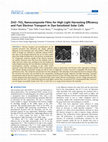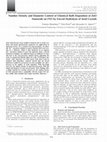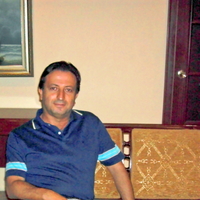Papers by venkata manthina
In perovskite solar cells and optoelectronics, perovskite film morphology controls the performanc... more In perovskite solar cells and optoelectronics, perovskite film morphology controls the performance of the device. Various methods have been developed to control the morphology and coverage of the perovskite films. In this article platelet type perovskite morphlogy was synthesized using low temperature vacuum impregnation of the perovskite solution CH 3 NH 3 PbI 3 resulting in complete coverage on TiO 2 film. Vacuum impregnation synthesis of perovskites has the advantage of low cost and low temperature which faciliates application in flexible electronics and solar cells.
ABSTRACT Abstract not Available.

Electrochimica Acta, 2015
As dye-sensitized solar cells (DSSCs) transition from iodide/triiodide-based electrolytes to orga... more As dye-sensitized solar cells (DSSCs) transition from iodide/triiodide-based electrolytes to organometallic complex redox couples with higher rates of recombination with electrons in the semiconductor, there is a need for semiconductor nanostructures that can rapidly transport electrons out of the device while maintaining high surface areas for the semiconductor/dye/electrolyte interface. A previously reported composite, with TiO 2 nanoparticles coating ZnO nanorods, met these criteria but suffered from a barrier to electron transfer from the TiO 2 to the ZnO. Here, the band edge positions of the TiO 2 and ZnO have been shifted by doping with Zr 4+ and Co 2+ , respectively, to arrive at the desired energetic alignment. The materials were characterized using diffuse-reflectance spectroscopy and a three-electrode measurement of the open circuit photovoltage under bandgap excitation (OCV). The OCV measurement indicated that the doping moved the conduction band minimum of ZnO to a more positive potential than that of the TiO 2 , enabling electron transfer from dye-sensitized TiO 2 nanoparticles to the underlying ZnO nanorods for efficient charge collection. However, DSSC devices fabricated with the composite nanostructures did not show improved performance. This paper details a methodology for producing and measuring band-edge shifts along with the benefits and limitations thereof.
Bulletin of the American Physical Society, Feb 28, 2012
Zinc oxide (ZnO) nanorods were grown on various substrates by a chemical growth process based on ... more Zinc oxide (ZnO) nanorods were grown on various substrates by a chemical growth process based on a ZnO seed solution, and starting from Zinc acetate (ZnAc) material. The nanorods were grown on insulating silicon (low doped) and oxidized silicon substrates, and also over patterned conducting (highly-doped) nanocrystalline silicon microwires. When high voltage is applied directly to the ZnO film using tungsten needles ($\ sim $50-60 V across $\ sim $5-10$\ mu $ m), high intensity blue and white light emission is observed, both in air and ...

Atmospheric pressureZnO microplasmas have been generated by high amplitude single pulses and DC v... more Atmospheric pressureZnO microplasmas have been generated by high amplitude single pulses and DC voltages applied using micrometer-separated probes on ZnO nanoforests. The high voltage stress triggers plasma breakdown and breakdown in the surrounding air followed by sublimation of ZnO resulting in strong blue and white light emission with sharp spectral lines and non-linear current-voltage characteristics. The nanoforests are made of ZnO nanorods (NRs) grown on fluorine doped tin oxide (FTO) glass, poly-crystalline silicon and bulk p-type silicon substrates. The characteristics of the microplasmas depend strongly on the substrate and voltage parameters. Plasmas can be obtained with pulse durations as short as ∼1 μs for FTO glass substrate and ∼100 ms for the silicon substrates. Besides enabling plasma generation with shorter pulses, NRs on FTO glass substrate also lead to better tunability of the operating gas temperature. Hot and cold ZnO microplasmas have been observed with these NRs on FTO glass substrate. Sputtering of nanomaterials during plasma generation in the regions surrounding the test area has also been noticed and result in interesting ZnO nanostructures (‘nano-flowers’ and ‘nano-cauliflowers’). A practical way of generating atmospheric pressureZnO microplasmas may lead to various lighting, biomedical and material processing applications.
Charge recombination at the electrode/electrolyte interface can be prevented by efficient blockin... more Charge recombination at the electrode/electrolyte interface can be prevented by efficient blocking layers. Here, TiO2 blocking layers have been deposited using atomic layer deposition (ALD) and TiCl4 treatment. The number of TiO2 ALD cycles was optimized for I−/I3− and Fc/Fc+ electrolytes. The optimized TiO2 ALD films' performance was compared with the TiCl4 treated films. TiCl4 treated films performed better than the ALD deposited films, attributed to reduction of the defects, which act as active sites of recombination.

As dye-sensitized solar cells (DSSCs) transition from iodide/triiodide-based electrolytes to orga... more As dye-sensitized solar cells (DSSCs) transition from iodide/triiodide-based electrolytes to organometallic complex redox couples with higher rates of recombination with electrons in the semiconductor, there is a need for semiconductor nanostructures that can rapidly transport electrons out of the device while maintaining high surface areas for the semiconductor/dye/electrolyte interface. A previously reported composite, with TiO 2 nanoparticles coating ZnO nanorods, met these criteria but suffered from a barrier to electron transfer from the TiO 2 to the ZnO. Here, the band edge positions of the TiO 2 and ZnO have been shifted by doping with Zr 4+ and Co 2+ , respectively, to arrive at the desired energetic alignment. The materials were characterized using diffuse-reflectance spectroscopy and a three-electrode measurement of the open circuit photovoltage under bandgap excitation (OCV). The OCV measurement indicated that the doping moved the conduction band minimum of ZnO to a more positive potential than that of the TiO 2 , enabling electron transfer from dye-sensitized TiO 2 nanoparticles to the underlying ZnO nanorods for efficient charge collection. However, DSSC devices fabricated with the composite nanostructures did not show improved performance. This paper details a methodology for producing and measuring band-edge shifts along with the benefits and limitations thereof.

Since ammonia is the most important TC to be captured, data on TC sorption presented in this pape... more Since ammonia is the most important TC to be captured, data on TC sorption presented in this paper are limited to ammonia, with results relevant to other TCs to be reported at a later time. The currently available life support systems use separate units for carbon dioxide, trace contaminants, and moisture control, and the long-term objective is to replace the above three modules with a single one. Furthermore, the current TC-control technology involves the use of a packed bed of acid-impregnated granular charcoal, which is non-regenerable, and the carbon-based sorbent under development in this project can be regenerated by exposure to vacuum at room temperature. The objective of this study was to demonstrate the feasibility of using carbon sorbents for the reversible, concurrent sorption of carbon dioxide and ammonia. Several carbon sorbents were fabricated and tested, and multiple adsorption/vacuum-regeneration cycles were demonstrated at room temperature, and also a carbon surface conditioning technique that enhances the combined carbon dioxide and ammonia sorption without impairing sorbent regeneration.

Electron transport and recombination are the essential processes that determine the charge collec... more Electron transport and recombination are the essential processes that determine the charge collection efficiency in dye-sensitized solar cells (DSSC). While nearly 100% of charges are collected in well-built ordinary DSSCs, this value can be sharply reduced by the use of redox couples other than iodide/triiodide due to fast electron recombination. To compensate, structures capable of fast electron transport are needed. Nanorod arrays that have this attribute tend to suffer from low surface area, resulting in low dye loading and reduced light harvesting. We have therefore developed a novel nanocomposite structure consisting of zinc oxide (ZnO) nanorods coated with titanium dioxide (TiO 2 ) nanoparticles using an electrostatic layer-by-layer (LbL) deposition technique. The titanium dioxide nanoparticle coating can add an order of magnitude of surface area and is compatible with known highperformance dyes. This composite nanostructure has been designed to take advantage of the improved electron transport along the nanorods and surface area provided by the nanoparticles, yielding good charge collection and light harvesting. Transient measurements indicate that the composite film can transport electrons at least 100 times faster than a nanoparticulate TiO 2 film. In tests using ferrocene/ferrocenium as a model alternative redox couple with fast recombination, current−voltage measurements indicate that the ZnO−TiO 2 hybrid films generate much higher currents than conventional TiO 2 nanoparticulate films. However, not all charges successfully transfer from TiO 2 to ZnO due to an energy barrier between the materials.

ZnO nanorods have been studied extensively due to facile synthesis and useful optoelectronic prop... more ZnO nanorods have been studied extensively due to facile synthesis and useful optoelectronic properties for applications in nanoscale devices. In a common two-step procedure, an ethanolic Zn 2+ precursor solution is used to deposit ZnO seed crystals on a substrate, which is then immersed in an aqueous Zn 2+ precursor solution to grow the nanorods. Here, a forced hydrolysis technique was employed based on additions of water and heat to the seed precursor solution before depositing the seeds on commercial fluorine-doped tin oxide (FTO)/glass substrates. ZnO nanorods were then grown from these seeds by chemical bath deposition. Analyses showed that the forced hydrolysis resulted in an increase in seed crystallite size and a decrease in the number of seeds deposited. With increasing seed size, the number density of nanorods decreased, while the length and diameter of each rod increased. These findings offer a simple method for exerting control over the number density of ZnO nanorods that is compatible with the rough FTO surface, unlike other methods that require smoother substrates.








Uploads
Papers by venkata manthina